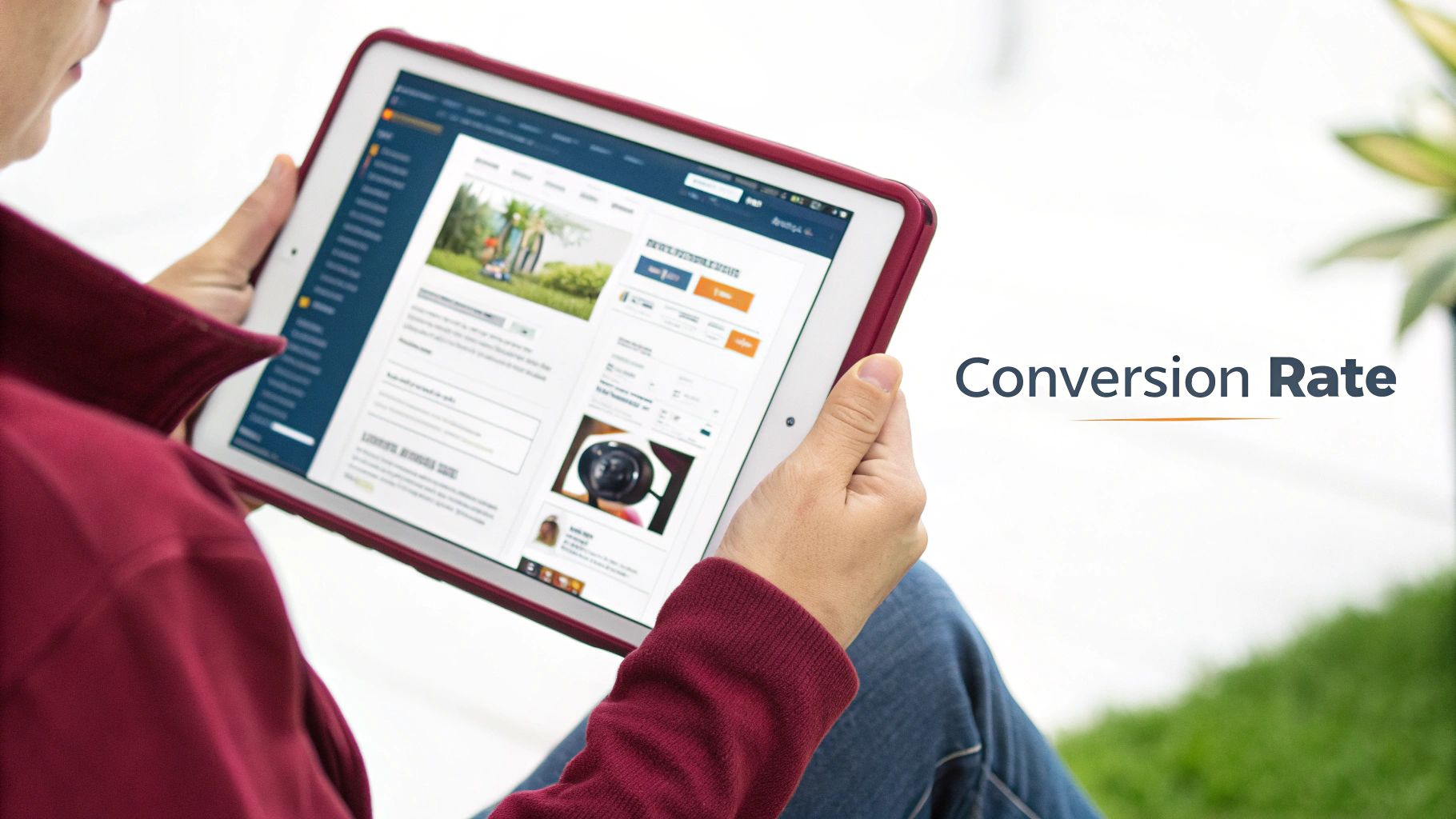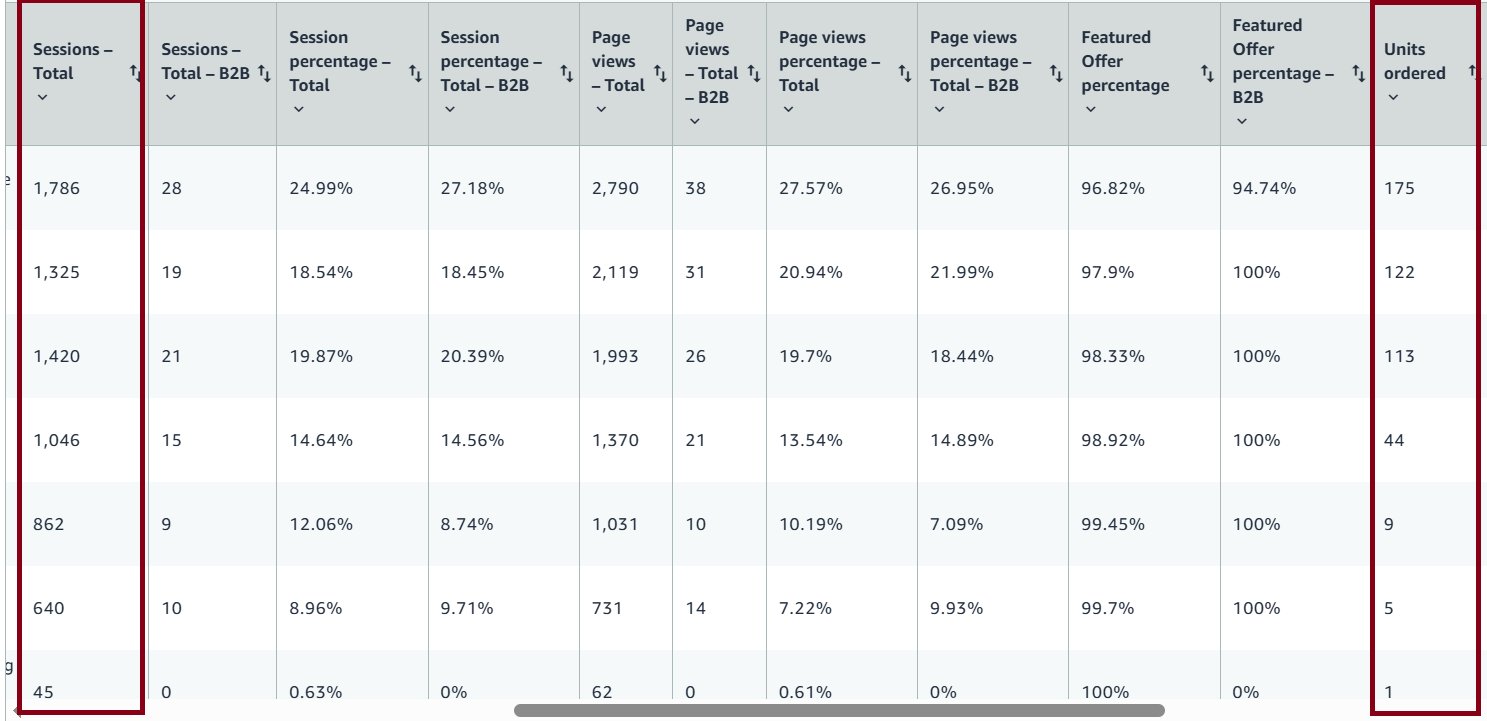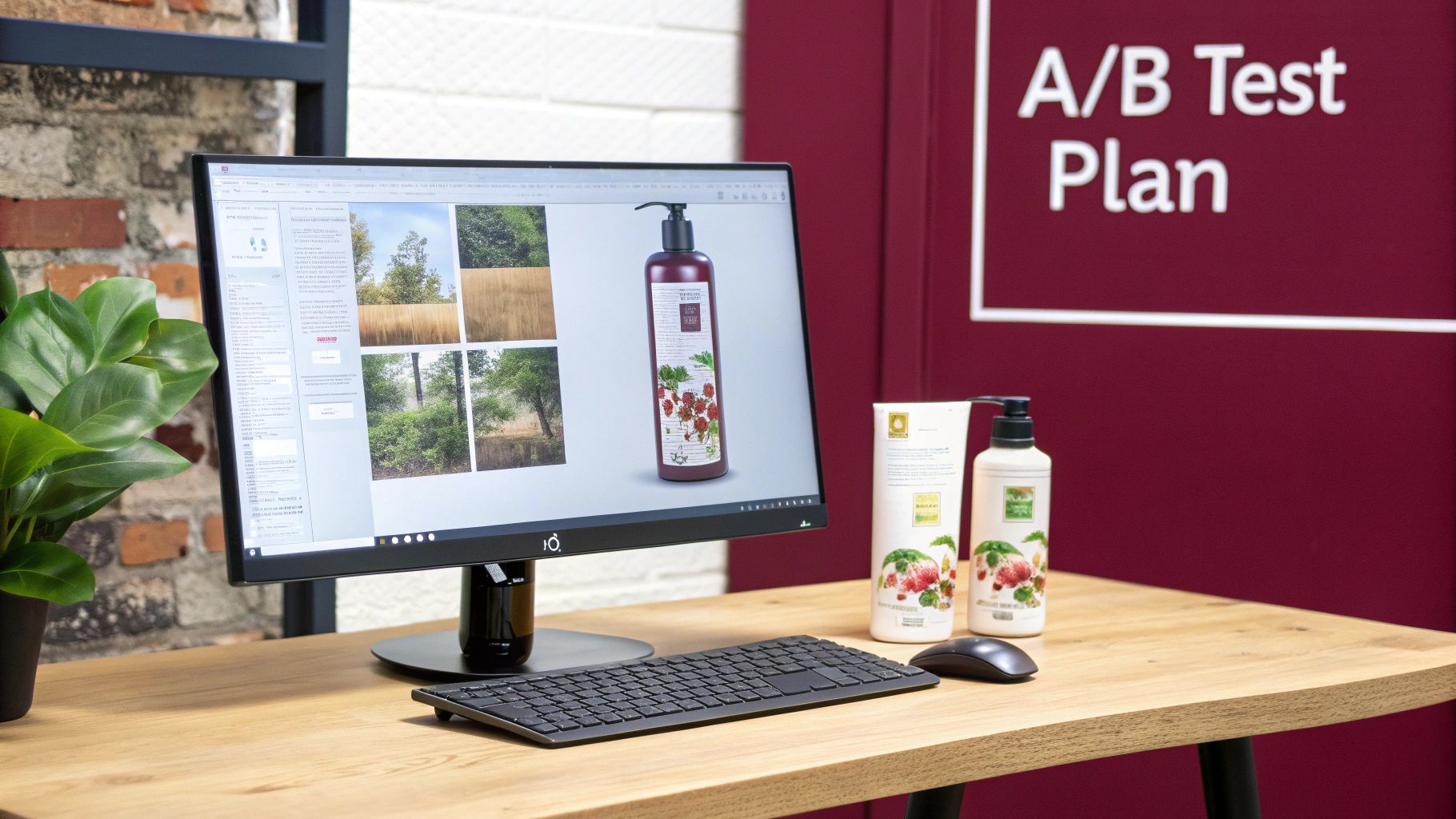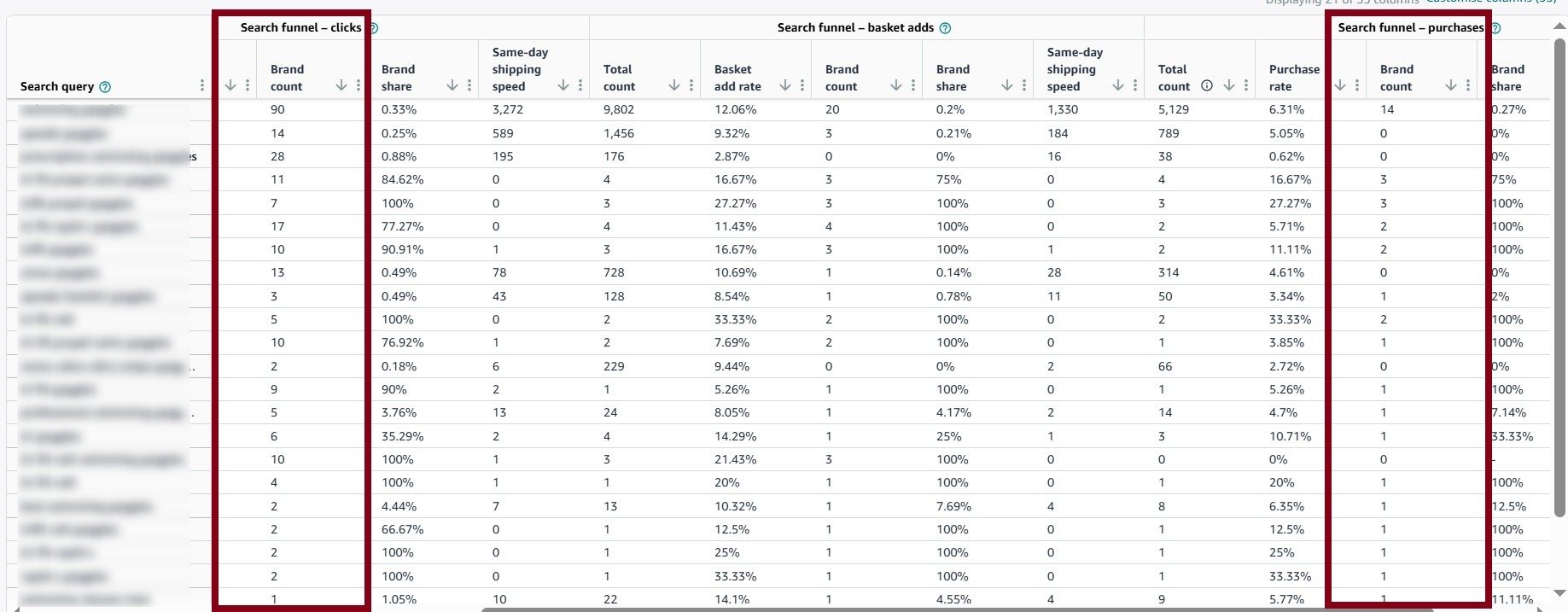Your Amazon conversion rate, known as ‘Unit Session Percentage’ in Seller Central business report, is an important metric that shows how effectively your product page turns traffic into sales. It answers a simple question: out of all the shoppers who land on your page, what percentage actually makes a purchase? A high conversion rate signals to Amazon’s A9 algorithm that your product meets customer expectations, directly influencing your success.
Why Conversion Rate Matters
Your conversion rate is a direct measure of your product listing’s health and effectiveness. It impacts nearly every aspect of your Amazon business, creating a positive feedback loop when optimized correctly. A strong conversion rate demonstrates that your offer, images, and copy resonate with shoppers.
How Conversion Rate Affects Ranking & Sales
- Higher Organic Rankings: Amazon’s primary goal is to sell products. A high conversion rate tells the A9 algorithm that your product is a strong seller, which often leads to better organic ranking in search results.
- Increased Sales Velocity: The more visitors you convert, the more units you sell in a given period. This increase in sales velocity is a powerful signal to Amazon, further improving your product’s ranking.
- Better Ad Performance: A well-converting listing makes every ad dollar more efficient. When shoppers who click your ads are likely to buy, your Advertising Cost of Sales (ACoS) decreases, and your campaigns become more profitable.

What Amazon Conversion Rate Means
To improve your conversion rate, you first need to understand how Amazon calculates it. The metric is straightforward but relies on specific definitions for sessions and orders.
1. Session
A session refers to a unique visitor viewing your product detail pages within a 24-hour period. A single shopper can generate multiple page views, but it will only count as one session. This metric helps you understand how many distinct potential customers are looking at your product.
2. Order
An order is counted when a customer completes the checkout process for one or more of your products. Amazon tracks the total number of orders placed, which is a key component of the conversion rate calculation.

3. How Conversion Rate is Calculated?
Conversion Rate (Unit Session Percentage) = (Total Orders / Total Sessions) x 100
For example, if your product page received 1,000 sessions and generated 100 orders in a month, your conversion rate would be 10%.
4. Where to Find Conversion Rate in Seller Central
You can find this data in your Seller Central account by navigating to Reports > Business Reports > Detail Page Sales and Traffic. The “Unit Session Percentage” column shows the conversion rate for each of your products.

What Is a Good Conversion Rate on Amazon?
Knowing your conversion rate is the first step. The next is determining whether it’s good, average, or needs improvement. Benchmarks provide the context you need to set realistic performance goals.
1. Average Conversion Rate
Amazon’s conversion rate is significantly higher than that of a typical ecommerce website. Shoppers arrive on Amazon with high purchase intent, and the platform is built on trust and convenience.
As of 2024-2025, data shows the average Amazon conversion rate is between 9.87% and 10.33%. Compare that to the average 1.33% for standalone ecommerce sites. The Prime badge is a major factor; Prime members convert up to 74% of the time. You can review more of these key Amazon conversion statistics to understand the platform’s power.
2. Practical Ranges Sellers Use
A marketplace-wide average isn’t a useful personal goal. Your “good” conversion rate depends on your category, price, and product maturity. Here’s a more practical way to assess your performance:
- Under 5%: This indicates a problem. Something on your listing is likely turning shoppers away, such as a poor main image, a high price, or a lack of reviews.
- 5% to 10%: A common starting point. This is a decent foundation for new products or those in competitive niches, but there’s significant room for improvement.
- 10% to 20%: You’re doing well. Your listing is effective, your offer is compelling, and you have sufficient social proof. The focus now shifts to fine-tuning and A/B testing.
- Over 20%: Elite performance. Products at this level are often best-sellers with strong brand recognition and thousands of positive reviews.
3. Why Category Differences Matter
Your performance should be measured against your direct competitors, not a generic marketplace average. A seller in electronics will have a very different “good” conversion rate than someone selling supplements. Understanding your category’s dynamics is key.
Amazon Conversion Rate by Category
A common mistake is comparing your performance to a marketplace-wide average. The reality is that your Amazon conversion rate is heavily influenced by your product category. Customer mindset and purchase behavior vary wildly between different types of products.
1. High-Converting Categories
Some categories are natural conversion leaders due to repeat purchases, low price points, and minimal buyer hesitation. These are often consumables or essential items.
- Health & Household: Shoppers frequently reorder these items, often using Subscribe & Save, which builds loyalty and drives quick conversions.
- Beauty & Personal Care: Similar to health products, many beauty items are consumables with high repeat purchase rates.
- Grocery & Gourmet Food: These are often low-consideration purchases that shoppers add to their carts with little deliberation.
Sponsored Products in a category like Health & Household can achieve an average conversion rate of 14.6%, well above the platform average.
2. Moderate-Converting Categories
These categories contain products that require some consideration but are not major investments. Shoppers may compare a few options before buying.
- Toys & Games
- Pet Supplies
- Sports & Outdoors
3. Lower-Converting Categories
These categories include high-ticket items or products that require significant research. Shoppers take more time to compare features, read reviews, and check competitor offers.
- Electronics: A new laptop is a major purchase involving extensive research, bringing the average conversion rate down to around 3.6%.
- Home & Kitchen Appliances: Buying a new vacuum or air fryer is a considered decision, not an impulse buy.
- Automotive Parts: Compatibility is a major friction point. Buyers must ensure a part fits their specific vehicle, which slows down the purchase process.
Your goal is to outperform the average for your specific category. For more insights on what makes products successful, see our guide on what products sell best on Amazon.
Amazon Advertising Conversion Rate
Your advertising conversion rate is a specific metric that measures the effectiveness of your PPC campaigns. It shows what percentage of ad clicks result in a sale.
1. Definition and Formula
The formula is:
Ad Conversion Rate = (Orders from Ads / Clicks on Ads) x 100
This metric helps you evaluate both your ad targeting and your listing’s performance.
2. Typical Ad Conversion Rate
The average advertising conversion rate on Amazon is around 10-15%. This high rate is due to the strong purchase intent of shoppers clicking on ads within the Amazon ecosystem.
3. What Strong Ad conversion Indicates
A high ad conversion rate means two things are working well:
- Your keyword targeting is accurate, attracting genuinely interested shoppers.
- Your product listing is optimized enough to close the deal once they arrive.
4. What Weak Ad Conversion Indicates
A low ad conversion rate signals a disconnect. It could mean you’re targeting irrelevant keywords or that your product page isn’t meeting the expectations set by your ad. For example, bidding on “blender” for a small, personal-sized model will attract shoppers looking for larger appliances, leading to wasted clicks.
Strategies to Improve Amazon Conversion Rate
Improving your Amazon conversion rate requires a systematic approach to optimizing every element of your product listing. Here’s an actionable checklist to turn more visitors into buyers.

1. Improve Listing Relevance
Your listing must immediately confirm to a shopper that they’ve found the right product. This starts with clear, relevant keyword placement.
- Keyword Placement: Include your main keyword within the first 80 characters of your title. Avoid keyword stuffing; focus on readability.
- Clarity: Use your title, bullets, and description to answer customer questions before they’re asked. Each bullet point should address a key feature or benefit.
- For a deep dive, our guide on comprehensive Amazon listing optimization is a great resource.
2. Strengthen Product Presentation
Shoppers on Amazon buy with their eyes. Your images are your most powerful sales tool and must tell a compelling story.
- High-Quality Images: Your main image must be on a pure white background and look professional. All other images should be high-resolution.
- Lifestyle Photos: Show your product in a real-world context to help customers visualize it in their lives.
- Infographics: Use text and icons on images to call out key features, dimensions, or benefits for easy scanning.
- Product Videos: A short video can demonstrate your product in action and explain its benefits more effectively than static images.
3. Improve Product Storytelling
Your copy should connect with the shopper by showing how your product solves their problem.
- Clear Benefits: Don’t just list features. Explain why they matter. Instead of “durable construction,” say “built to last, so you won’t need to buy a replacement next year.”
- Solution-Focused Messaging: Frame your product as the answer to a specific pain point. Always write from the customer’s perspective, answering their unspoken question: “What’s in it for me?”
4. Optimize for Mobile Shoppers
A significant portion of Amazon traffic comes from mobile devices, where screen space is limited.
- Title Structure: Place your most important information and keywords in the first 70-80 characters, as the rest is often cut off on mobile.
- Image Order: Ensure your most compelling images are among the first few in the gallery.
- Bullet Point Readability: Keep bullets short and scannable. Long paragraphs are difficult to read on a small screen.
5. Use A+ Content Effectively
A+ Content is a powerful tool for brand building and providing a richer shopping experience. Use it strategically.
- Key Modules: Use a mix of modules to showcase features, tell your brand story, and provide detailed information.
- Comparison Charts: These are highly effective for showing how your product stands out from competitors or other models in your lineup.
- Brand Story Section: Connect with customers on a personal level by sharing your mission and what your brand represents.
6. Improve Your Offer
Sometimes the listing is perfect, but the offer isn’t competitive. Your offer includes your price, shipping, and promotions.
- Competitive Pricing: You don’t need to be the cheapest, but your price must be in line with customer expectations for your category.
- Coupons and Deals: The small coupon badge is a powerful psychological trigger that can be enough to secure a sale.
- Subscribe and Save: For consumable products, this is an excellent way to lock in repeat customers and encourage initial purchases.
7. Increase Trust and Social proof
Reviews are the currency of trust on Amazon. A product with few reviews will struggle against one with hundreds.
- Amazon Vine: For new products, the Vine program is one of the best ways to get early, credible reviews.
- Review Generation: Implement a consistent strategy to encourage new reviews from satisfied customers.
- Review Quality: The recency and quality of your reviews are just as important as the total number.
8. Fix Fulfillment and Delivery
How you get your product to the customer can significantly impact conversion.
- FBA or Prime Eligibility: The Prime badge is a massive conversion driver. If you’re not using FBA, consider Seller Fulfilled Prime.
- Inventory Stability: Running out of stock kills sales velocity and can harm your ranking. Maintain stable inventory levels.
- Shipping Reliability: Ensure your delivery promises are accurate to maintain customer trust.
9. Improve Traffic Quality
Driving low quality traffic to your listing can hurt your conversion rate and waste your ad budget.
- Fixing Bad Keyword Targeting: Use your PPC search term report to identify and negate keywords that get clicks but no sales.
- Attracting Higher Intent Visitors: Focus your ad campaigns on long-tail keywords that indicate a shopper is closer to making a purchase.
10. Run Structured A/B tests
Use data, not guesswork, to optimize your listing. Amazon’s “Manage Your Experiments” tool is perfect for this.
- Titles and Main Images: Test different versions to see what resonates most with shoppers.
- A+ Content Layouts: Experiment with different modules and designs.
- Price Tests: Test small price adjustments to find the optimal balance between profit and conversion.
11. Perform Competitor Gap Analysis
Understand what top sellers in your niche are doing right and find opportunities to stand out.
- What Top Sellers Are Doing: Analyze their keywords, images, price, copy, and A+ content.
- Missing Features: Read competitor reviews to find common complaints that your product addresses.
- Ways to Stand Out: Identify weaknesses in their listings that you can exploit.
For more on using data to drive growth, this resource on E-Commerce Growth Data Analysis Tools is helpful.

Tools and Reports for Monitoring Conversion
Consistently tracking your conversion rate is essential for sustained growth. Several tools, both within and outside of Seller Central, can provide the insights you need.
1. Seller Central Business Reports
Your primary source of data is the Detail Page Sales and Traffic report in Seller Central. This is where you’ll find your Unit Session Percentage (conversion rate), sessions, page views, and Buy Box percentage for every product.

2. Amazon PPC Reports
The Search Term Report in your advertising console is invaluable for analyzing traffic quality. It shows you the exact customer search terms that triggered your ads, allowing you to identify and negate irrelevant terms that are wasting your budget and lowering your ad conversion rate. Stay updated on how ad tools work together, like these Amazon Ad Server integrations).
3. Amazon Search Query Performance Report
The Amazon Search Query Performance Report provides insights into how search queries are performing. To track the conversion rate, divide Search funnel – purchases by Search funnel – clicks for specific search terms.

Frequently Asked Questions
Here are answers to some common questions sellers have about Amazon conversion rates.
1. What is the Amazon conversion rate formula?
The formula is (Total Orders ÷ Total Sessions/clicks) x 100. Amazon refers to this metric as the Unit Session Percentage in Seller Central reports.
2. What is considered a good conversion rate?
A “good” rate is relative to your category. However, a general guideline is:
- Below 5% indicates a problem with product or listing.
- 10-15% is considered good.
- Over 20% is excellent.
3. Why do conversion rates differ by category?
Conversion rates vary due to differences in price, purchase consideration, and buying frequency. A low-cost, consumable item like dog food will naturally have a higher conversion rate than a high-ticket item like a laptop, which requires extensive research.
4. What is Amazon advertising conversion rate?
This metric measures the percentage of ad clicks that result in a sale. It helps you evaluate the effectiveness of your ad targeting and the quality of the traffic your campaigns are driving.
5. How often should sellers track conversion?
It’s a good practice to check your conversion rate weekly to spot any significant trends. However, for strategic decisions, you should analyze the 2-weeks average to get a more stable and reliable view of your performance, smoothing out daily fluctuations.
6. Why does high conversion but low sales mean you need more traffic?
This scenario means your product page is effective at converting the visitors it gets, but not enough people are finding it. The problem isn’t your listing; it’s a lack of visibility. Your focus should shift from conversion optimization to driving more qualified traffic through SEO and targeted PPC campaigns. Understanding how this connects to your ad spend is also key; you can learn more about your Amazon ACoS and how it all ties together.





